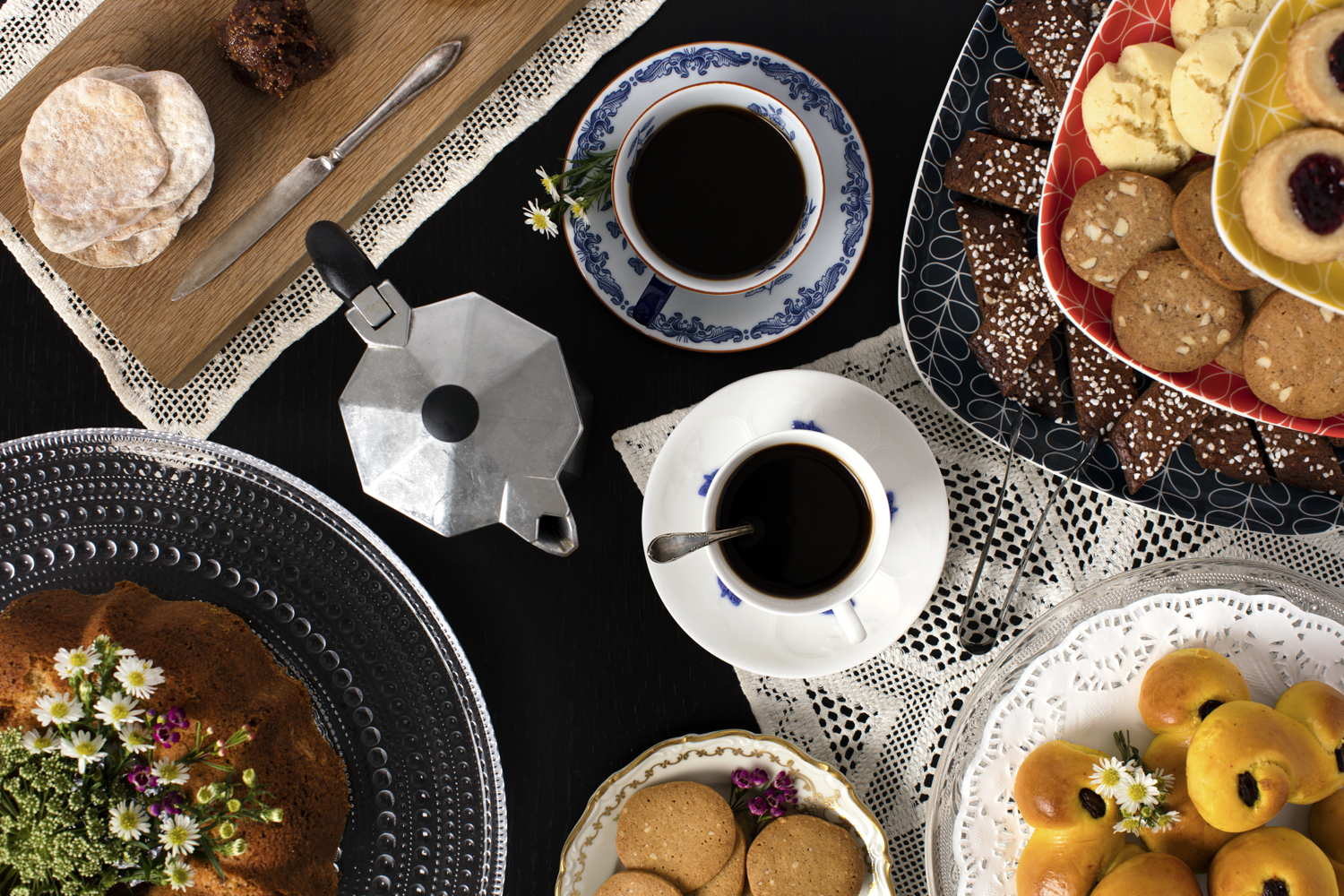Fika’s about making time for something warm and delicious. I learn this over homemade cardamom cake and Assam tea, from the co-authors of Fika: the Art of the Swedish Coffee Break. There’s a tea kettle on the table, along with some duck-shaped pepparkakor (gingersnap cookies) that writer and illustrator Johanna Kindvall made for us to savor while talking fika.
Kindvall came to New York from Sweden more than a decade ago, surprised to discover that most co-workers at her employer (an architectural firm) didn’t have coffee together. Sure, they grabbed a cup of joe in the break room, but mostly took it back to their desks in paper cups. In Sweden, fika is more or less culturally mandated; it’s customary to bring homemade buns or jam thumbprint cookies to the office, use ceramic dishes and sit down with co-workers for awhile before heading back to work.

“You get the evil eye in Sweden, if you skip fika,” Kindvall adds.
Fika’s about paying attention, whether you’re eating chokladbollar (chocolate balls known to every Swedish child) or apple pie. “The effort of making and appreciating handmade things is a major aspect of the tradition,” says Fika co-author Anna Brones. More often than not, fika is done at home or an office, even a neighborhood bakery if pressed for time, but what about fika-ing at a rapidly expanding coffee chain?
Fika NYC, which opened in New York nearly 10 years ago and now has 17 shops in Manhattan, offers to-go options for busy New Yorkers, as well as porcelain coffee mugs, smoked salmon wraps and Swedish meatballs. “We want people to feel as comfortable meeting for business here as going on a date,” says founder Lars Åkerlund. The Scandinavian-run chain offers a wide assortment of baked goods, from croissants and pain au chocolat to traditional Swedish pastries like prinsesstårta—a green-marzipan-coated cake layered with fresh cream and jam.
Even the jam is made in-house, Åkerlund tells me over espresso and matcha at the company’s 10th Avenue location, where Fika’s buns and cookies are made daily. (The coffee is roasted in Brooklyn, and they serve New York–based SerendipiTea.) “Everything we do starts from high-quality, locally sourced ingredients and is carried out with attention to detail at every stage of the process,” he adds, “from the cardamom buns to the Long Island–made boxes that house our chocolates.”
The fika tradition is, after all, about quality. Fika authors Kindvall and Brones suggest crushing cardamom pods with a mortar and pestle, for example, rather than using ground-up spices. This flourish was evident in the cake Kindvall whipped up and her just-out-of-the-oven rye bread with anise and pulsed raisins. The essence of fika radiated from these gestures: a natural reverence for coziness and hospitality that comes from a culture of welcoming people in from the cold.
Likewise, partygoers knew they’d stumbled on something unique when Swedish-born Ulrika Pettersson brought cookies to her daughter’s birthday, inspiring her to found Unna Bakery. She learned the recipes from her mother and grandmother, based on a 19th-century social custom requiring women to serve seven sorts of cookies at gatherings. These lady-only kaffereps could get a tad competitive: Making fewer than seven different cookies might be considered cheap; more than seven, haughty. (A hostess also had to select the finest coffee cups, embroidered linens and flowers.)

Unna Bakery’s airy dream cookies and refined gingersnaps are made at the Harlem incubator Hot Bread Kitchen along with other delicacies from the Swedish cookie canon. They’re sold online and at stores like Schaller & Weber, as well as artisanal cheese shop Lucy’s Whey and Brooklyn’s Nordic coffee mecca, Buðin (where you can find wildflowers on each table and a small, highly curated selection of Scandinavian ceramics). Try the chocolate-caramel with coffee—the secret ingredient’s a syrup you can’t find in New York, Pettersson revealed to me, while the taste of pure caramel lingered on my palate.
Fika NYC, meanwhile, puts a modern, global twist on the Swedish tradition,” says head baker Robert Tell, who previously worked in some of Stockholm’s best patisseries and was named one of the 10 best bread bakers in America by Dessert Professional. He’s done pumpkin-chai buns for Fika’s bun-of-the-month lineup as well as a more classic lussekatter for the holidays—with almond cream and a saffron and Cognac simple syrup: a good choice for fika. “People seem to enjoy our Swedish baked goods like the prinsesstårta,” he added. “It’s a fresh and striking cake.”
Fika isn’t just about the pastries, though. It’s the spirit of taking a few moments, genuinely connecting with others and appreciating the craft of well-made food and drink. Many customers, I noticed, swung by Fika NYC for a quick coffee and croissant, rushing out the door or heading straight for their laptops. A real fika might start by turning off the phone, then asking for an espresso and slice of prinsesstårta to stay. Take a minute to unwind and you can actually taste the raspberries in the jam.



